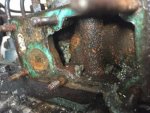I'm still going over a 78ish B7100 that I picked up a month ago and playing catch up on fluids and the such. I honestly think it was a fuel and go machine for the past few years based on what I've seen. A slight belt tightening last night turned into failed Dynamo bearings this morning. I finally pulled the Dynamo off after a 2 hour struggle with corroded studs and was shocked to see jellyfish looking slime in the block. I read an old school technique for flushing with vinegar. Does this actually work? I hope to get to that point soon if I can find the bearings locally.
Attachments
-
20.5 KB Views: 291


